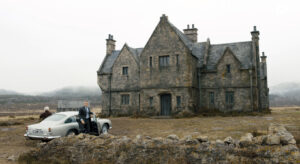Lomography has long been celebrated for its dedication to analog photography and innovative design, but its latest release—a retro brass camera—is a standout piece that perfectly captures the essence of 1960s chic. The camera, with its sleek brass finish and minimalist aesthetic, evokes a bygone era of sophisticated style and serves as a testament to Lomography’s commitment to merging artistic expression with nostalgic allure.
A Design Rooted in 1960s Elegance
The camera’s design is a love letter to the 1960s, an era defined by bold experimentation and timeless elegance in both fashion and technology. The brass exterior isn’t merely an aesthetic choice; it’s a tactile experience that recalls the feeling of vintage cameras, when photography was as much about the physical interaction with your equipment as it was about capturing the world through your lens. The matte finish and brushed metal details give the camera an authentic retro vibe, making it a piece that stands out whether it’s being used or displayed as a collectible.
But beyond its striking appearance, the camera’s brass body also offers durability, ensuring that this piece is more than just a stylish nod to the past—it’s built to last. The weight of the brass provides a satisfying heft that feels substantial in the hand, reminiscent of the robust build quality of vintage cameras from brands like Leica and Rolleiflex. This combination of design and material makes the camera a perfect fit for both enthusiasts of retro aesthetics and serious photographers seeking a reliable, unique tool for their craft.
Analog Photography Meets Modern Functionality
True to Lomography’s ethos, the retro brass camera embraces analog photography’s imperfections and unpredictability, offering users a chance to create art that’s rich in texture and character. The camera is equipped with a variety of manual settings, giving photographers control over focus, exposure, and aperture, while maintaining the simplicity that made 1960s cameras so accessible and enjoyable to use.
The inclusion of multiple lens attachments further expands the creative possibilities, allowing photographers to experiment with different focal lengths and visual effects. Whether you’re shooting in vibrant color or dramatic black and white, the brass camera’s optics are designed to produce images with a distinct analog feel—soft vignettes, saturated hues, and the occasional light leak that has become a signature of Lomography’s unique style.
This retro brass camera isn’t just a nostalgic throwback—it’s also equipped with some modern conveniences that enhance the analog experience. The camera’s film advance mechanism, for example, is smoother and more reliable than those found in typical vintage models, reducing the risk of film jams or overlapping exposures. A hot shoe mount allows users to attach external flashes or other accessories, bridging the gap between classic design and contemporary functionality.
The Resurgence of Analog: Why This Camera Matters
In an age dominated by digital photography and smartphones, the allure of analog photography has made a surprising resurgence. Lomography, which was founded in the early 1990s as a reaction to the rise of digital imaging, has been at the forefront of this movement, championing the aesthetic and experiential qualities of film photography. The retro brass camera is a continuation of this mission, offering a tangible connection to the past that digital cameras simply can’t replicate.
For many, analog photography represents a deliberate choice to slow down and engage with the photographic process in a more thoughtful way. It’s about the ritual of loading film, adjusting settings manually, and waiting for the right moment to release the shutter. The brass camera, with its elegant design and emphasis on manual controls, invites users to embrace this slower, more intentional approach.
The camera’s brass finish also speaks to the resurgence of retro aesthetics in modern design culture. As more people seek out products that feel authentic and handcrafted, Lomography’s brass camera stands as an icon of timeless design—one that bridges the gap between the mid-century modernist sensibilities of the 1960s and the contemporary craving for tactile, visually striking objects.
A Collector’s Item and a Creative Tool
With its striking appearance and superb craftsmanship, the retro brass camera is poised to become a coveted item among collectors and photography aficionados alike. Its limited production run ensures that it will remain a rare and valuable piece, making it not just a tool for creative expression but also a worthwhile investment for those who appreciate fine craftsmanship and design.
Yet, for all its collector’s appeal, the camera is ultimately meant to be used. Lomography’s philosophy has always centered on the idea of creative experimentation and breaking free from the constraints of conventional photography. This camera, despite its premium materials and finish, is no exception. It encourages photographers to push the boundaries of their creativity, to embrace the unexpected, and to find joy in the art of analog photography.
A Nostalgic Revival That Resonates Today
The retro brass camera by Lomography is more than just a nostalgic homage to the 1960s—it’s a celebration of the enduring appeal of analog photography in an increasingly digital world. It stands as a reminder that photography isn’t just about the final image, but about the experience, the interaction, and the tangible connection to the medium.
For those who remember the golden age of film, the camera is a welcome revival that evokes the sights, sounds, and sensations of a time when photography was a more deliberate, intimate practice. For younger generations discovering the magic of analog for the first time, it offers a glimpse into a world where images weren’t instantaneous but carefully crafted with light, film, and chemistry.
With its perfect blend of form and function, Lomography’s retro brass camera is a triumph of design that pays homage to the past while inspiring new creative possibilities. It’s an invitation to slow down, embrace the unpredictable, and capture moments with a piece of photographic history reimagined for the present day.
No comments yet.







